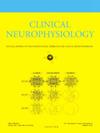下低频头皮脑电图与烟雾病中一过性神经事件密切相关。
IF 3.7
3区 医学
Q1 CLINICAL NEUROLOGY
引用次数: 0
摘要
背景:短暂性神经系统事件(TNEs)通常发生在烟雾病(MMD)的直接血运重建术后。虽然脑血流(CBF)的变化可能与tes有关,但其潜在机制尚不清楚。在此,我们研究了TNE和EEG之间的关系,以阐明潜在的机制,并寻求EEG作为TNE生物标志物的临床应用。方法:对22例年龄≥15岁接受血运重建术的烟雾病患者的26个半球进行分析。利用临床资料分析术后7天内的头皮脑电图(EEG)和单光子发射计算机断层扫描(SPECT)。结果:26个脑半球中有16个出现TNEs,其中12个脑半球术后脑电图δ波频率增加(>.5,< 4 Hz) (P = 0.0002),位于与各症状一致的区域。在TNE发育当天,所有4个半球均观察到次慢活动(ISA, < 0.33 Hz)。术后两脑脑电图多发于发病前的δ波。CBF在有和没有TNEs的患者之间没有差异。结论:ISA可能与TNEs的病理生理有关。δ波可以作为临床生物标志物来预测TNEs。意义:头皮脑电图慢波具有预测和阐明脑内神经网络的潜力。非标准缩写和缩略语。短暂性神经事件;烟雾病;ISA,次流活动;SD,扩频去极化;TC,时间常数。本文章由计算机程序翻译,如有差异,请以英文原文为准。
Infraslow scalp electroencephalogram is closely linked to transient neurological events in Moyamoya disease
Background
Transient neurological events (TNEs) commonly occur following direct revascularization for moyamoya disease (MMD). Although changes in the cerebral blood flow (CBF) may be linked to TNEs, the underlying mechanism remains unclear. Herein, we investigated the relationship between TNEs and EEG to elucidate the underlying mechanisms and pursue the clinical utility of EEG as a TNE biomarker.
Methods
Twenty-six hemispheres in 22 patients with MMD aged ≥15 years who underwent revascularization were analyzed. Scalp electroencephalography (EEG) and single-photon emission computed tomography (SPECT) performed within 7 days postoperatively were analyzed using the clinical information.
Results
Sixteen of 26 hemispheres developed TNEs, of which 12 demonstrated an increased frequency of delta waves (> 0.5, < 4 Hz) on postoperative EEG (P = 0.0002), which was located in an area consistent with each symptom. Infraslow activity (ISA, < 0.33 Hz) was observed in all 4 hemispheres on the day of TNE development. More frequent occurrence of delta wave on postoperative EEG preceded onset in 2 hemispheres. CBF did not differ between the patients with and without TNEs.
Conclusions
ISA may be associated with the pathophysiology of TNEs. Delta waves can be used as clinical biomarkers to predict TNEs.
Significance
Slow waves on scalp EEG have the potential can predict and elucidate TNEs.
Non-standard Abbreviations and Acronyms.
TNEs, transient neurological events; MMD, Moyamoya disease; ISA, infraslow activity; SD, spreading depolarization; TC, time constant.
求助全文
通过发布文献求助,成功后即可免费获取论文全文。
去求助
来源期刊

Clinical Neurophysiology
医学-临床神经学
CiteScore
8.70
自引率
6.40%
发文量
932
审稿时长
59 days
期刊介绍:
As of January 1999, The journal Electroencephalography and Clinical Neurophysiology, and its two sections Electromyography and Motor Control and Evoked Potentials have amalgamated to become this journal - Clinical Neurophysiology.
Clinical Neurophysiology is the official journal of the International Federation of Clinical Neurophysiology, the Brazilian Society of Clinical Neurophysiology, the Czech Society of Clinical Neurophysiology, the Italian Clinical Neurophysiology Society and the International Society of Intraoperative Neurophysiology.The journal is dedicated to fostering research and disseminating information on all aspects of both normal and abnormal functioning of the nervous system. The key aim of the publication is to disseminate scholarly reports on the pathophysiology underlying diseases of the central and peripheral nervous system of human patients. Clinical trials that use neurophysiological measures to document change are encouraged, as are manuscripts reporting data on integrated neuroimaging of central nervous function including, but not limited to, functional MRI, MEG, EEG, PET and other neuroimaging modalities.
 求助内容:
求助内容: 应助结果提醒方式:
应助结果提醒方式:


